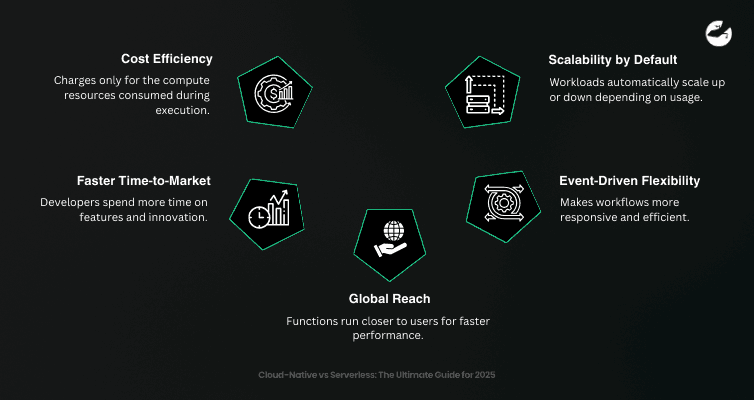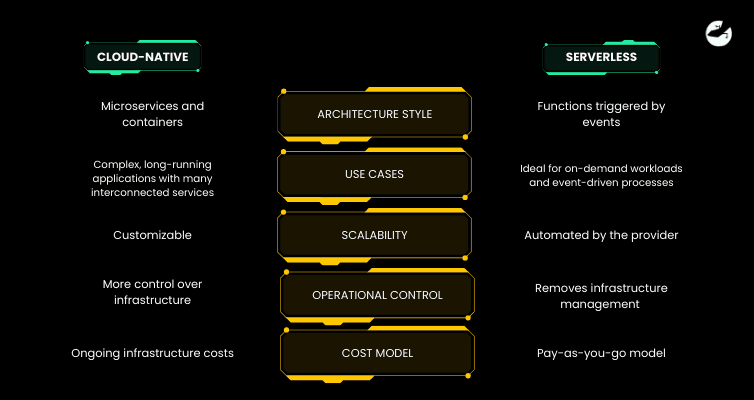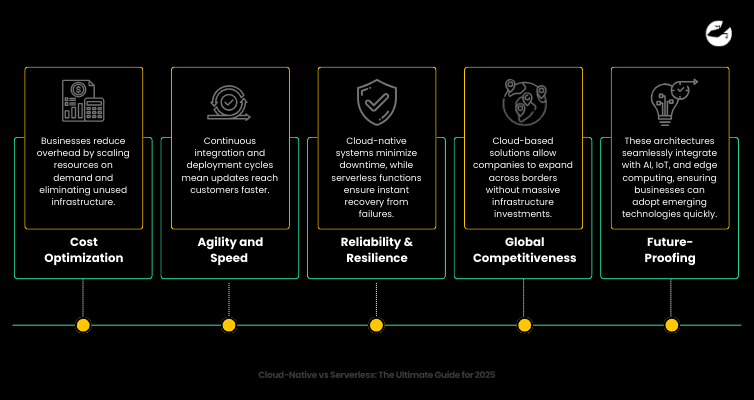Cloud-Native Architecture
Serverless Architecture
+ 2 more ...
Cloud-Native vs Serverless: The Ultimate Guide for 2025

28 Aug 2025
by Nadiy, Senior Content Writer

28 Aug 2025
by Nadiy, Senior Content Writer
Cloud-Native Architecture
Serverless Architecture
Mobile App Development
Software Development
Cloud-Native vs Serverless: The Ultimate Guide for 2025
Table of contents
Contact us
We will get back to you in the next 48 hours.

Cloud-Native vs Serverless The Ultimate Guide for 2025
Cloud-native and serverless architectures are transforming how businesses innovate in 2025. Learn how these powerful approaches drive scalability, efficiency, and future-proof digital products, and why forward-thinking companies are embracing them today.
key takeaways
is evolving at a rapid pace, and the way businesses build and scale applications is shifting just as quickly. Cloud-native and serverless architectures have emerged as the backbone of modern digital strategies, giving companies the ability to innovate faster, reduce operational costs, and deliver seamless user experiences.
But what exactly do these architectures mean in 2025, and how can businesses harness them to stay competitive? Let’s break down the essentials and explore why these approaches are shaping the future of digital products.
What Is Cloud-Native Architecture?
Cloud-native architecture is more than just running applications in the cloud—it’s aboutdesigning software that is purpose-built for the cloud environment. It refers to building and running applications that fully leverage cloud computing models.
Instead of lifting and shifting legacy systems into the cloud, cloud-native applications are built to take full advantage of distributed, scalable, and flexible cloud infrastructure.
This approach allows businesses to build resilient, adaptive systems that evolve as customer and market demands change.

Key Characteristics of Cloud-Native Architecture
In 2025, cloud-native isn’t just a buzzword—it’s a necessity. With more organizations transitioning to multi-cloud and hybrid-cloud strategies, businesses gain the agility to adapt quickly to market changes.
Understanding what makes an application cloud-native comes down to a few defining traits:
- Microservices-based: Instead of being built as a single monolithic application, cloud-native apps are broken into smaller, independent services that can be developed, deployed, and scaled separately.
- Containerized: By using container technologies like Docker and Kubernetes, cloud-native applications achieve consistency and portability across development, testing, and production environments.
- Automated Scaling: Cloud-native systems are built to automatically expand or contract resources in real time, ensuring performance during peak usage without wasting costs in downtime.
- Continuous Delivery & DevOps: Cloud-native embraces modern DevOps practices, allowing updates to be tested and rolled out continuously with minimal disruption.
- Resilient by Design: If one microservice fails, the system is designed to recover without taking down the entire application.
Cloud-native architecture is the foundation of scalable, agile digital platforms. By adopting this approach, businesses position themselves to adapt quickly, innovate consistently, and serve customers without compromise.
What Is Serverless Architecture?
Serverless architecture takes the abstraction of infrastructure even further. While servers still exist behind the scenes, developers no longer need to manage them. Instead, they write code in the form of functions that are triggered by events, while the cloud provider handles the provisioning, scaling, and maintenance of the underlying infrastructure.
This model has redefined how applications are deployed, particularly for startups, SaaS platforms, and enterprises that want to innovate rapidly without the burden of server management.

Benefits of Serverless Architecture
Serverless is moving beyond simple applications in 2025. Businesses now rely on serverless models for mission-critical workloads, machine learning pipelines, and real-time data processing.
Serverless architecture provides distinct advantages that go beyond cost savings:
- Cost Efficiency: Unlike traditional server models where you pay for uptime, serverless charges only for the compute resources consumed during execution.
- Faster Time-to-Market: Developers spend less time on infrastructure and more on features and innovation.
- Scalability by Default: Workloads automatically scale up or down depending on usage, eliminating the need for manual resource planning.
- Event-Driven Flexibility: Ideal for tasks triggered by user actions, IoT devices, or scheduled jobs, serverless makes workflows more responsive and efficient.
- Global Reach: Most serverless platforms are integrated with global edge networks, ensuring functions run closer to users for faster performance.
Serverless architecture empowers businesses to move faster, cut costs, and innovate without infrastructure bottlenecks. By enabling developers to focus solely on solving business problems, it’s become a game-changer in modern digital development.
Cloud-Native vs Serverless: Key Differences
While cloud-native and serverless share the same philosophy of leveraging the cloud to its fullest, they are designed for different use cases. Understanding the nuances helps businesses decide when to use one, the other, or both.

- Architecture Style: Cloud-native is built around microservices and containers, while serverless is powered by functions triggered by events.
- Use Cases: Cloud-native is best for complex, long-running applications with many interconnected services. Serverless is ideal for on-demand workloads and event-driven processes.
- Scalability by Default: Both scale automatically, but cloud-native scaling is more customizable, while serverless scaling is fully automated by the provider.
- Operational Control: Cloud-native provides more control over infrastructure, while serverless removes almost all infrastructure management responsibilities.
- Cost Model: Cloud-native typically involves ongoing infrastructure costs, while serverless follows a pay-as-you-go model.
The choice between cloud-native and serverless isn’t binary. The two can complement each other—using cloud-native for core applications and serverless for supporting functions creates an architecture that balances flexibility, performance, and cost-efficiency.
Why Businesses Are Adopting These Architectures in 2025
The rise of cloud-native and serverless isn’t just about technology trends—it’s a response to business needs. Companies today must deliver faster, scale smarter, and operate more cost-effectively to compete.
Key drivers behind adoption include:
- Cost Optimization: Businesses reduce overhead by scaling resources on demand and eliminating unused infrastructure.
- Agility and Speed: Continuous integration and deployment cycles mean updates reach customers faster.
- Reliability and Resilience: Cloud-native systems minimize downtime, while serverless functions ensure instant recovery from failures.
- Global Competitiveness: Cloud-based solutions allow companies to expand across borders without massive infrastructure investments.
- Future-Proofing: These architectures seamlessly integrate with AI, IoT, and edge computing, ensuring businesses can adopt emerging technologies quickly.
Adopting cloud-native and serverless is no longer about staying ahead of the curve—it’s about staying in the game. Businesses embracing these models are creating the agility and resilience required to thrive in rapidly changing digital markets.
Want to find out how much it costs to build your dream app or web app?
Challenges to Consider
Despite their advantages, both cloud-native and serverless architectures come with challenges. Businesses must anticipate these to avoid roadblocks.
- Vendor Lock-In: Relying heavily on a single cloud provider can limit flexibility and increase switching costs.
- Management Complexity: Cloud-native microservices can become difficult to monitor and coordinate without the right tools.
- Cold Starts in Serverless: Serverless functions may experience delays when invoked after a period of inactivity.
- Security Risks: Distributed systems create a larger attack surface, requiring advanced monitoring and compliance strategies.
- Cost Overruns: While both models save money, poor planning or uncontrolled scaling can lead to unexpected expenses.
These challenges are not deal-breakers but require careful planning, strong governance, and experienced partners. With the right strategy, businesses can mitigate risks and maximize the value of these architectures.
The Future Outlook of Cloud-Native and Serverless
Looking ahead, both cloud-native and serverless architectures will continue to evolve, pushing the boundaries of what’s possible in digital product development.

Trends shaping the future include:
- AI-Powered Orchestration: Smarter, automated resource management to reduce costs and improve performance.
- Multi-Cloud Normalization: Businesses increasingly design applications to run seamlessly across multiple cloud providers.
- Deeper DevOps Integration: Both architectures will integrate more tightly with CI/CD pipelines and infrastructure-as-code.
- Expanded Industry Adoption: From healthcare to finance, cloud-native and serverless will become the default foundation for mission-critical applications.
- Stronger Edge Computing Synergy: Applications will process data closer to users, combining cloud-native resilience with serverless responsiveness.
The future of software lies in architectures that are adaptive, resilient, and cost-efficient. Cloud-native and serverless are not temporary trends—they are long-term strategies redefining how businesses deliver digital solutions. Companies that embrace them today are setting themselves up to lead tomorrow.
How Lizard Global Helps You Succeed
Cloud-native and serverless architectures are no longer optional—they are essential strategies for businesses aiming to thrive in 2025 and beyond. By enabling flexibility, cost savings, and rapid innovation, these approaches allow companies to deliver digital solutions that scale with confidence.

At Lizard Global, we help organizations navigate this complexity by designing and building cloud-native applications, deploying serverless solutions, and ensuring strong security across environments. Whether you’re modernizing legacy systems or launching a cutting-edge platform, our expertise ensures you can harness the full potential of cloud-native and serverless technologies. Together, we make your digital vision future-ready.
Join 2000+ subscribers
Stay in the loop with everything you need to know

Cloud-Native vs Serverless The Ultimate Guide for 2025
Cloud-native and serverless architectures are transforming how businesses innovate in 2025. Learn how these powerful approaches drive scalability, efficiency, and future-proof digital products, and why forward-thinking companies are embracing them today.
is evolving at a rapid pace, and the way businesses build and scale applications is shifting just as quickly. Cloud-native and serverless architectures have emerged as the backbone of modern digital strategies, giving companies the ability to innovate faster, reduce operational costs, and deliver seamless user experiences.
But what exactly do these architectures mean in 2025, and how can businesses harness them to stay competitive? Let’s break down the essentials and explore why these approaches are shaping the future of digital products.
What Is Cloud-Native Architecture?
Cloud-native architecture is more than just running applications in the cloud—it’s aboutdesigning software that is purpose-built for the cloud environment. It refers to building and running applications that fully leverage cloud computing models.
Instead of lifting and shifting legacy systems into the cloud, cloud-native applications are built to take full advantage of distributed, scalable, and flexible cloud infrastructure.
This approach allows businesses to build resilient, adaptive systems that evolve as customer and market demands change.

Key Characteristics of Cloud-Native Architecture
In 2025, cloud-native isn’t just a buzzword—it’s a necessity. With more organizations transitioning to multi-cloud and hybrid-cloud strategies, businesses gain the agility to adapt quickly to market changes.
Understanding what makes an application cloud-native comes down to a few defining traits:
- Microservices-based: Instead of being built as a single monolithic application, cloud-native apps are broken into smaller, independent services that can be developed, deployed, and scaled separately.
- Containerized: By using container technologies like Docker and Kubernetes, cloud-native applications achieve consistency and portability across development, testing, and production environments.
- Automated Scaling: Cloud-native systems are built to automatically expand or contract resources in real time, ensuring performance during peak usage without wasting costs in downtime.
- Continuous Delivery & DevOps: Cloud-native embraces modern DevOps practices, allowing updates to be tested and rolled out continuously with minimal disruption.
- Resilient by Design: If one microservice fails, the system is designed to recover without taking down the entire application.
Cloud-native architecture is the foundation of scalable, agile digital platforms. By adopting this approach, businesses position themselves to adapt quickly, innovate consistently, and serve customers without compromise.
What Is Serverless Architecture?
Serverless architecture takes the abstraction of infrastructure even further. While servers still exist behind the scenes, developers no longer need to manage them. Instead, they write code in the form of functions that are triggered by events, while the cloud provider handles the provisioning, scaling, and maintenance of the underlying infrastructure.
This model has redefined how applications are deployed, particularly for startups, SaaS platforms, and enterprises that want to innovate rapidly without the burden of server management.

Benefits of Serverless Architecture
Serverless is moving beyond simple applications in 2025. Businesses now rely on serverless models for mission-critical workloads, machine learning pipelines, and real-time data processing.
Serverless architecture provides distinct advantages that go beyond cost savings:
- Cost Efficiency: Unlike traditional server models where you pay for uptime, serverless charges only for the compute resources consumed during execution.
- Faster Time-to-Market: Developers spend less time on infrastructure and more on features and innovation.
- Scalability by Default: Workloads automatically scale up or down depending on usage, eliminating the need for manual resource planning.
- Event-Driven Flexibility: Ideal for tasks triggered by user actions, IoT devices, or scheduled jobs, serverless makes workflows more responsive and efficient.
- Global Reach: Most serverless platforms are integrated with global edge networks, ensuring functions run closer to users for faster performance.
Serverless architecture empowers businesses to move faster, cut costs, and innovate without infrastructure bottlenecks. By enabling developers to focus solely on solving business problems, it’s become a game-changer in modern digital development.
Cloud-Native vs Serverless: Key Differences
While cloud-native and serverless share the same philosophy of leveraging the cloud to its fullest, they are designed for different use cases. Understanding the nuances helps businesses decide when to use one, the other, or both.

- Architecture Style: Cloud-native is built around microservices and containers, while serverless is powered by functions triggered by events.
- Use Cases: Cloud-native is best for complex, long-running applications with many interconnected services. Serverless is ideal for on-demand workloads and event-driven processes.
- Scalability by Default: Both scale automatically, but cloud-native scaling is more customizable, while serverless scaling is fully automated by the provider.
- Operational Control: Cloud-native provides more control over infrastructure, while serverless removes almost all infrastructure management responsibilities.
- Cost Model: Cloud-native typically involves ongoing infrastructure costs, while serverless follows a pay-as-you-go model.
The choice between cloud-native and serverless isn’t binary. The two can complement each other—using cloud-native for core applications and serverless for supporting functions creates an architecture that balances flexibility, performance, and cost-efficiency.
Why Businesses Are Adopting These Architectures in 2025
The rise of cloud-native and serverless isn’t just about technology trends—it’s a response to business needs. Companies today must deliver faster, scale smarter, and operate more cost-effectively to compete.
Key drivers behind adoption include:
- Cost Optimization: Businesses reduce overhead by scaling resources on demand and eliminating unused infrastructure.
- Agility and Speed: Continuous integration and deployment cycles mean updates reach customers faster.
- Reliability and Resilience: Cloud-native systems minimize downtime, while serverless functions ensure instant recovery from failures.
- Global Competitiveness: Cloud-based solutions allow companies to expand across borders without massive infrastructure investments.
- Future-Proofing: These architectures seamlessly integrate with AI, IoT, and edge computing, ensuring businesses can adopt emerging technologies quickly.
Adopting cloud-native and serverless is no longer about staying ahead of the curve—it’s about staying in the game. Businesses embracing these models are creating the agility and resilience required to thrive in rapidly changing digital markets.
Want to find out how much it costs to build your dream app or web app?
Challenges to Consider
Despite their advantages, both cloud-native and serverless architectures come with challenges. Businesses must anticipate these to avoid roadblocks.
- Vendor Lock-In: Relying heavily on a single cloud provider can limit flexibility and increase switching costs.
- Management Complexity: Cloud-native microservices can become difficult to monitor and coordinate without the right tools.
- Cold Starts in Serverless: Serverless functions may experience delays when invoked after a period of inactivity.
- Security Risks: Distributed systems create a larger attack surface, requiring advanced monitoring and compliance strategies.
- Cost Overruns: While both models save money, poor planning or uncontrolled scaling can lead to unexpected expenses.
These challenges are not deal-breakers but require careful planning, strong governance, and experienced partners. With the right strategy, businesses can mitigate risks and maximize the value of these architectures.
The Future Outlook of Cloud-Native and Serverless
Looking ahead, both cloud-native and serverless architectures will continue to evolve, pushing the boundaries of what’s possible in digital product development.

Trends shaping the future include:
- AI-Powered Orchestration: Smarter, automated resource management to reduce costs and improve performance.
- Multi-Cloud Normalization: Businesses increasingly design applications to run seamlessly across multiple cloud providers.
- Deeper DevOps Integration: Both architectures will integrate more tightly with CI/CD pipelines and infrastructure-as-code.
- Expanded Industry Adoption: From healthcare to finance, cloud-native and serverless will become the default foundation for mission-critical applications.
- Stronger Edge Computing Synergy: Applications will process data closer to users, combining cloud-native resilience with serverless responsiveness.
The future of software lies in architectures that are adaptive, resilient, and cost-efficient. Cloud-native and serverless are not temporary trends—they are long-term strategies redefining how businesses deliver digital solutions. Companies that embrace them today are setting themselves up to lead tomorrow.
How Lizard Global Helps You Succeed
Cloud-native and serverless architectures are no longer optional—they are essential strategies for businesses aiming to thrive in 2025 and beyond. By enabling flexibility, cost savings, and rapid innovation, these approaches allow companies to deliver digital solutions that scale with confidence.

At Lizard Global, we help organizations navigate this complexity by designing and building cloud-native applications, deploying serverless solutions, and ensuring strong security across environments. Whether you’re modernizing legacy systems or launching a cutting-edge platform, our expertise ensures you can harness the full potential of cloud-native and serverless technologies. Together, we make your digital vision future-ready.
Join 2000+ subscribers
Stay in the loop with everything you need to know
FAQs

How is cloud-native different from serverless?
Can cloud-native and serverless be used together?
Is serverless architecture always cheaper than cloud-native?
What challenges come with cloud-native architecture?
What challenges come with serverless architecture?
Which industries benefit most from cloud-native and serverless?
How can Lizard Global help with cloud-native and serverless adoption?
Are cloud-native applications more secure than traditional apps?
How does serverless handle security?
Which cloud providers offer cloud-native and serverless solutions?
How do I decide between cloud-native and serverless?
similar reads







